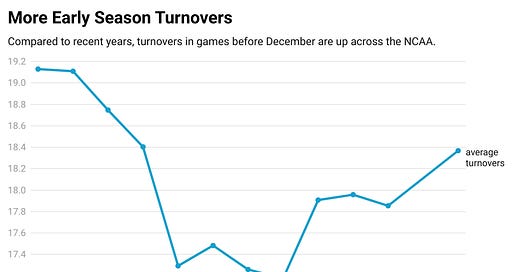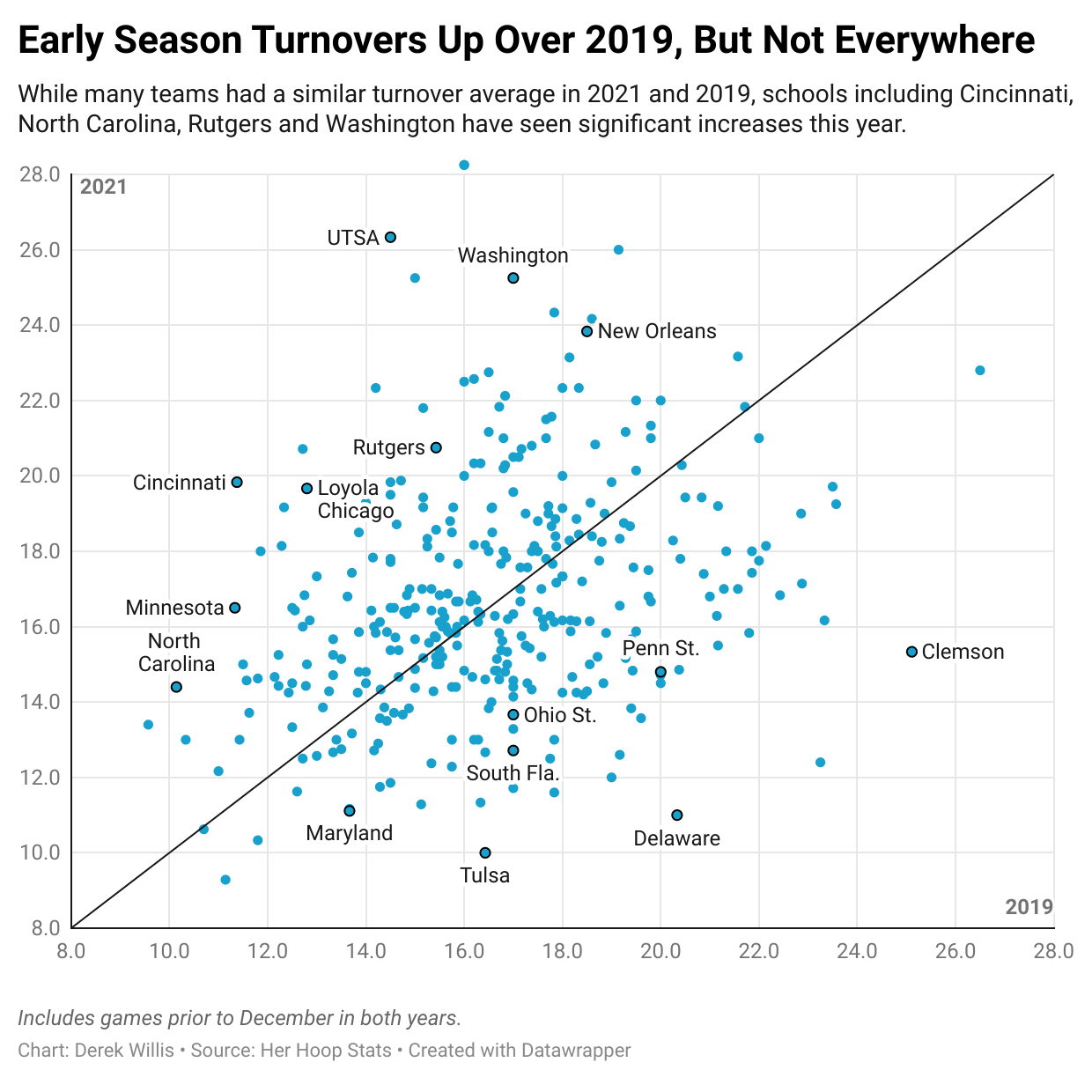Early Season Means More Turnovers
The average number of turnovers in pre-December games was up this season, part of a trend since 2013, even as overall turnovers are declining.
Thanks for reading the Her Hoop Stats Newsletter. If you like our work, be sure to check out our stats site, our podcast, and our social media accounts on Twitter, YouTube, Facebook, and Instagram. You can also buy Her Hoop Stats gear, such as laptop stickers, mugs, and shirts!
Haven’t subscribed to the Her Hoop Stats Newsletter yet?
Fans of women’s college basketball have seen a lot already this season: dramatic upsets, a slew of contests between top-ranked teams and dominating individual performances.
On average, they’ve also seen more turnovers, which have been creeping upwards each November for the past nine years.
The change isn’t huge in absolute terms: teams averaged 18.4 turnovers a game in games prior to December this year, compared to 17.8 in early 2019. The trend line, though, is what’s interesting - the early-season turnover average is the highest since 2012. (I’m including games before December for each year except 2020, when the season started late, in my calculation.)
Even a modest increase in turnovers impacts both team and individual performances. Turnovers can kill rallies, deflate crowds and put teams in holes they struggle to climb out from. And while many teams have cut their early season turnovers compared to 2019, the overall trend reflects a small but steady increase.
The good news is that what happens during the first weeks of the season often doesn’t hold for the entire season. Fans may see fewer players whistled for picking up their pivot feet or for stepping on the sideline. The average number of turnovers at the end of the 2020-21 season was 16.4 per game as teams gained game experience. Since the 2009-10 season, the average number of turnovers over an entire season has mostly declined.
The increase in early season turnover average is clear, but the reason for it is not. There are lots of theories. First, teams need that first month to improve their offensive execution and to acclimate teammates to each other. Second, officials have been focusing on calling traveling on perimeter players who pick up their pivot foot before dribbling the ball during the past few seasons (see page 15 from the 2020-21 officiating manual, for example). Third, the record number of transfers may be making it harder for teams to gel in the early going. Fourth, that sheer number of new players could mean that officials are seeing more players that they haven’t seen before. Fifth, injuries and illness may be forcing different lineups, leading to unexpected playing time for some players. Maybe the presence of crowds that were mostly absent last season are a factor.
The increase early this season isn’t just the result of a few turnover-prone outlier teams. Compared to the start of the 2019-20 season (the most recent one that started normally), there are dozens more teams averaging at least 18 turnovers a game this year.
Let’s focus on the 343 teams that Her Hoop Stats has turnover data for 2019 and 2021. Many of these teams are from large conferences and in theory should have a more stable base of players and performance.
There are some teams that have made significant improvements since 2019. They include Clemson, which has cut down its early-season turnover average from 25.1 to 16.2, and Penn State, which has 5.2 fewer turnovers on average. On the other end of the spectrum, teams like Loyola Chicago and Washington have averaged eight more turnovers a game compared to two years ago. Cincinnati, Rutgers and North Carolina have all seen significantly more turnovers so far this season compared to 2019 (and all have had transfer activity). In all, 52% of the teams have a higher turnover average in early 2021 compared to early 2019 (see an interactive version of this chart here).
I’ll keep tracking turnovers throughout the season to see how teams are doing, and if you have thoughts on why you’re seeing more of them this season that I haven’t explored, let me know in the comments.






